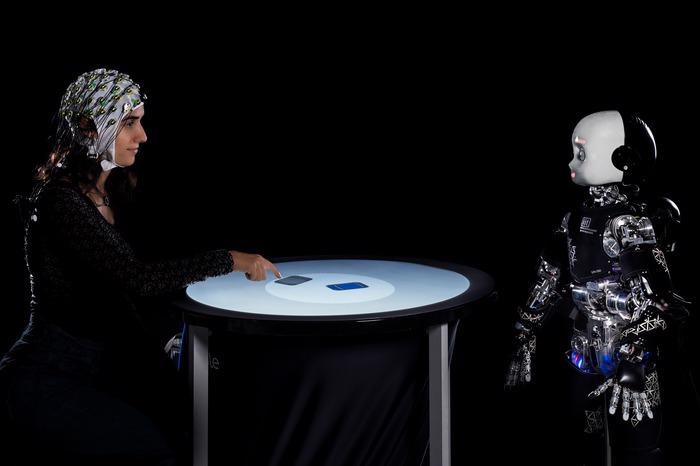Reviewed by Alex SmithSep 2 2021
Gaze is considered a deeply powerful and significant signal during human-to-human communication and interaction. This communicates intentions and informs about others’ decisions. The outcome of what happens when humans and robots gaze at each other is another question.
 Illustration of a human and a humanoid robot engaged in a competitive game, as reported in Belkaid et al. “Mutual gaze with a robot affects human neural activity and delays decision-making processes” (Science Robotics). The human is playing against the robot while her brain activity is being measured with an electroencephalogram (EEG). Image Credit: IIT-Istituto Italiano di Tecnologia.
Illustration of a human and a humanoid robot engaged in a competitive game, as reported in Belkaid et al. “Mutual gaze with a robot affects human neural activity and delays decision-making processes” (Science Robotics). The human is playing against the robot while her brain activity is being measured with an electroencephalogram (EEG). Image Credit: IIT-Istituto Italiano di Tecnologia.
Researchers from the IIT-Istituto Italiano di Tecnologia (Italian Institute of Technology), analyzed whether the gaze of a humanoid robot can impact the way people reason in a social decision-making context.
The researchers observed that a mutual gaze with the robot influences human neural activity and affects the decision-making process, specifically delaying the process. Therefore, a robot gaze makes a human consider it as a social signal. The observations have powerful implications for contexts where humanoids might be used as domestic assistants, co-workers or clinical support.
The study was published in the journal Science Robotics on September 1st, 2021.
The research lies within the framework of a larger overreaching project, which is headed by Agnieszka Wykowska, coordinator of IIT’s lab “Social Cognition in Human-Robot Interaction,” and financially supported by the European Research Council (ERC).
The project named “InStance” explains the time and conditions under which people treat robots as intentional beings. In other words, whether, to explain and interpret the behavior of the robot, people refer to mental states as desires or beliefs.
The authors of the paper include Marwen Belkaid, Kyveli Kompatsiari, Davide de Tommaso, Ingrid Zablith and Agnieszka Wykowska.
In many daily life situations, the human brain must engage not only in decision-making but also in anticipating and predicting the behavior of others. Thus, gaze can be highly informative about others’ intentions, upcoming decisions and goals.
Humans tend to direct attention to others’ eyes, and the brain reacts powerfully when someone looks at them or directs the gaze to a specific event or location in the environment. Researchers analyzed these kinds of interactions with a robot.
Robots will be more and more present in our everyday life. That is why it is important to understand not only the technological aspects of robot design, but also the human side of the human-robot interaction. Specifically, it is important to understand how the human brain processes behavioral signals conveyed by robots.
Agnieszka Wykowska, Study Senior Author and Principal Investigator, Italian Institute of Technology
The researchers involved 40 participants to play a strategic game, named the Chicken game. The game was played with a robot iCub while the behavioral and neural activity of the participants was measured.
The neural activity was measured using electroencephalography (EEG). The game is a tactical one, presenting a situation in which two drivers of simulated cars approach each other on a collision course. The results rely on whether the players yield or keep going straight.
The researchers observed that the participants responded slowly when iCub established a mutual gaze while making a decision, relative to averted gaze. The delayed process may indicate that mutual gaze requires higher cognitive effort, for instance, by eliciting more reasoning about iCub’s choices or a higher level of suppression of the potentially distracting gaze stimulus. This action was not relevant to the task.
Think of playing poker with a robot. If the robot looks at you during the moment you need to make a decision on the next move, you will have a more difficult time in making a decision, relative to a situation when the robot gazes away. Your brain will also need to employ effortful and costly processes to try to ‘ignore’ that gaze of the robot.
Agnieszka Wykowska, Study Senior Author and Principal Investigator, Italian Institute of Technology
The outcomes indicate that the robot’s gaze “hijacks” the “socio-cognitive” mechanisms of the human brain. This influences the brain to respond to the robot considering it as a social agent. In this regard, “being social” for a robot cannot always be beneficial for the human, interfering with their operation and speed of making decisions. This is the case even if their reciprocal interaction is engaging and enjoyable.
The researchers expect that these observations would support roboticists to develop robots that demonstrate behavior that is highly relevant for a certain context of the application.
Humanoids with social behavior can assist in elderly or child care, for instance, the iCub robot can support experimental therapy in the treatment of autism. By contrast, when a focus on a particular task is needed, similar to a factory setting or air traffic control, the presence of a robot expressing social signals might be a distraction.
Journal Reference:
Belkaid, M., et al. (2021) Mutual gaze with a robot affects human neural activity and delays decision-making processes. Science Robotics. doi.org/10.1126/scirobotics.abc5044.